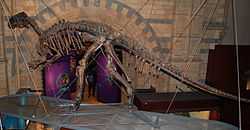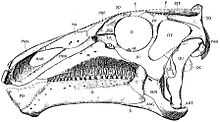Mantellisaurus
| Mantellisaurus Temporal range: Early Cretaceous, 125Ma | |
|---|---|
 | |
| Mounted skeleton, Natural History Museum, London | |
| Scientific classification | |
| Kingdom: | Animalia |
| Phylum: | Chordata |
| Clade: | Dinosauria |
| Order: | †Ornithischia |
| Clade: | †Ornithopoda |
| Clade: | †Styracosterna |
| Clade: | †Hadrosauriformes |
| Genus: | †Mantellisaurus Paul, 2007 |
| Species: | † M. atherfieldensis |
| Binomial name | |
| Mantellisaurus atherfieldensis (Hooley, 1925 [originally Iguanodon]) | |
| Synonyms | |
|
Heterosaurus neocomiensis Cornuel, 1850 (partim) | |
Mantellisaurus is a genus of dinosaur formerly known as Iguanodon atherfieldensis. The new genus was erected by Gregory Paul in 2007. According to Paul, it is more lightly built than Iguanodon and more closely related to Ouranosaurus, making Iguanodon in its traditional sense paraphyletic. It is known from many complete and almost complete skeletons. The genus name honours Gideon Mantell, the discoverer of Iguanodon. Mantellisaurus lived during the Early Cretaceous in what is now England.


Compared to Iguanodon bernissartensis, Mantellisaurus was smaller, estimated at 0.75 tons in weight. Its forelimbs were proportionally shorter than those of I. bernissartensis. In Mantellisaurus the forelimbs were about half the length of the hindlimbs whereas they were about 70 percent the length of the hindlimbs in I. bernissartensis. Due to the short length of its forelimbs and the shortness of its body, Paul proposed that it was primarily bipedal, only going on all fours when standing still or moving slowly.[1]
The type fossil was originally discovered by Reginald Walter Hooley in 1914 in the upper Vectis Formation of southern England and reported upon in 1917. He posthumously named it Iguanodon atherfieldensis in 1925. Atherfield is the name of a village on the southwest shore of the Isle of Wight where the fossil was found. Heterosaurus, Sphenospondylus, and Vectisaurus may or may not be synonyms of Mantellisaurus, because Paul (2007) did not address the status of each of these names. Each of these taxa were included as synonyms of I. atherfieldensis (as it was then known) in the 2004 review of Iguanodontia in The Dinosauria (2nd edition).[2] Other possible synonyms include Dollodon and Proplanicoxa.[3]
Synonyms
- Iguanodon atherfieldensis Hooley, 1925
- ?Cetiosaurus brachyurus Owen, 1842
- ?Heterosaurus neocombiensis Cornuel, 1850
- ?Sphenospondylus gracilis Lydekker, 1888
- ?Vectisaurus valdensis Hulke, 1879
References
- ↑ Paul, Gregory S. (2008). "A revised taxonomy of the iguanodont dinosaur genera and species". Cretaceous Research 29 (2): 192–216. doi:10.1016/j.cretres.2007.04.009.
- ↑ Norman, David B. (2004). "Basal Iguanodontia". In Weishampel, D.B., Dodson, P., and Osmólska, H. (eds.). The Dinosauria (2nd ed.). Berkeley: University of California Press. pp. 413–437. ISBN 0-520-24209-2.
- ↑ McDonald, Andrew T. (2011). "The status of Dollodon and other basal iguanodonts (Dinosauria: Ornithischia) from the upper Wealden beds (Lower Cretaceous) of Europe". Cretaceous Research advance online publication. doi:10.1016/j.cretres.2011.03.002.
- Cornuel, M., 1850, Note sur des ossements fossiles decouvertes dans le calcaire neocomien de Wassy (Haute-Marne): Bulletin de la societie geologiques de France, 2nd series, v. 7, p. 702-704.
- Hooley, W., 1925, On the skeleton of Iguanodon atherfieldensis sp. nov., from the Wealden Shales of Atherfield (Isle of Wight): Quarterly Journal of the Geological Society of London, v. 81, p. 1-61.
- Hulke, J. W., 1879, Vectisaurus valdensis, a new Wealden Dinosaur: Quarterly Journal of the Geological Society of London, v. 35, p. 421-424.
- Owen, R., 1842, Report on British Fossil Reptiles. Part II: Report of the British Association for the Advancement of Science, v. 11, p. 60-204.
- Lydekker, R., 1888, Catalogue of the Fossil Reptilia and Amphibia in the British Museum (Natural History), Cromwell Road, S.W., Part 1. Containing the Orders Ornithosauria, Crocodilia, Dinosauria, Squamta, Rhynchocephalia, and Proterosauria: British Museum of Natural History, London, 309pp.
- Norman, D.B., 2012. "Iguanodontian Taxa (Dinosauria: Ornithischia) from the Lower Cretaceous of England and Belgium". In: Pascal Godefroit (ed.), Bernissart Dinosaurs and Early Cretaceous Terrestrial Ecosystems. Indiana University Press. 464 pp. http://www.iupress.indiana.edu/product_info.php?products_id=800408
- Paul, G.S. 2007. Turning the old into the new: a separate genus for the gracile iguanodont from the Wealden of England; pp. 69–77 in K. Carpenter (ed.), Horns and Beaks: Ceratopsian and Ornithopod Dinosaurs. Indiana University Press, Bloomington.